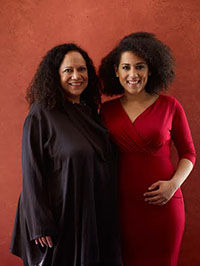Soul-Full
Alice Randall and Caroline Randall Williams remember the kitchens of their ancestors—and offer healthful versions of family staples
Don’t pick up Soul Food Love expecting the kind of food you put on a plate. For Alice Randall and Caroline Randall Williams, the mother-daughter pair of authors, this book is an elegy for the foods that nourished their ancestors, as well as an up-to-the-minute collection of flavor-forward recipes for sustainable, healthful eating.
 But first there’s the story of that soul food. “Five Kitchens,” the book’s opening section, is as good a telling as you’ll ever read of the personal-yet-universal saga of so many African-American families. The kitchen rapes and mixed-race ancestors. The entrenched economic inequality. The constant threat of violence. The move to the industrial North. The ambition, faith, entrepreneurial drive, and insistence on schooling. The eventual entrance to the middle class and beyond. Written mostly in Randall’s poetic prose, it’s compelling and occasionally wrenching: The stove in Randall’s grandmother’s kitchen, for example, was “a place to boil sassafras and blackberry root, eggshells, and iodide potash. As Grandma often told me, her aunt made her living delivering babies and curing venereal disease in the turpentine camps, where poor people, almost all black, toiled slashing cat faces into pine trees that would bleed gum to be boiled and distilled into turpentine and rosin. In Grandma’s memory, the home kitchen was a place for cooking up cures. And the kitchen where food was cooked was a place where you worked for other people.”
But first there’s the story of that soul food. “Five Kitchens,” the book’s opening section, is as good a telling as you’ll ever read of the personal-yet-universal saga of so many African-American families. The kitchen rapes and mixed-race ancestors. The entrenched economic inequality. The constant threat of violence. The move to the industrial North. The ambition, faith, entrepreneurial drive, and insistence on schooling. The eventual entrance to the middle class and beyond. Written mostly in Randall’s poetic prose, it’s compelling and occasionally wrenching: The stove in Randall’s grandmother’s kitchen, for example, was “a place to boil sassafras and blackberry root, eggshells, and iodide potash. As Grandma often told me, her aunt made her living delivering babies and curing venereal disease in the turpentine camps, where poor people, almost all black, toiled slashing cat faces into pine trees that would bleed gum to be boiled and distilled into turpentine and rosin. In Grandma’s memory, the home kitchen was a place for cooking up cures. And the kitchen where food was cooked was a place where you worked for other people.”
The narrative concludes with Williams’s own experiences of the black kitchen, at home and in school, but particularly in her job teaching in the Mississippi Delta. “Yes sometimes we live in food deserts. Sometimes the only grocery store is a Walmart,” she writes. “My students ate lots of takeout: Popeye’s chicken, ribs from Boss Hog’s, pizza from Subway. … And their choices, restaurant-wise, were my only choices too. If I wanted to keep the healthy body I’d fought for my whole life, I needed another option. One Sunday evening I finally swallowed my prejudice, and me and my high horse took our behinds to Walmart.”
For Randall and Williams, as for many African Americans, the early generations ate from scarcity: greens, oatmeal, sweet potato hash, and hen-in-the-pot; sugar tits for abandoned infants; barbecue and “Co-Cola” in better times. Later came chicken salad, layer cakes, pate, pepper jelly, and cheese balls. Later still, the devastating effects of fast food.
.jpg) Randall, like many baby boomers, learned to cook from Julia Child, the Joy of Cooking, and Craig Claiborne’s The New York Times Cookbook. Crepes, soufflés, tortes, beef Wellington, coulibiac—delicious food that’s an achievement as much as a meal, luxurious and dense with calories. But Randall has famously declared her intention to be her family’s “last fat black woman” and even set out some guidelines for achieving that goal in her most recent novel, Ada’s Rules. Her kitchen, known to many as the source of marvelous food, is now also a place for learning—and teaching—about how to eat differently.
Randall, like many baby boomers, learned to cook from Julia Child, the Joy of Cooking, and Craig Claiborne’s The New York Times Cookbook. Crepes, soufflés, tortes, beef Wellington, coulibiac—delicious food that’s an achievement as much as a meal, luxurious and dense with calories. But Randall has famously declared her intention to be her family’s “last fat black woman” and even set out some guidelines for achieving that goal in her most recent novel, Ada’s Rules. Her kitchen, known to many as the source of marvelous food, is now also a place for learning—and teaching—about how to eat differently.
“Differently” means cooking with an eye to health as well as to taste. The roster of hummus, kale, roast chicken, chickpeas, salmon, cucumber soup, and anything sweet potato will strike most cooks as a fairly accurate reflection of the way Americans eat now. But family recipes join the mix, as well: Randall’s grandmother’s decorative fruit ice cubes; Chicken Breasts with Grapes and Mushrooms, a dinner staple that Randall cooked for her abusive mother over and over again; pears poached in red wine that bonded Randall and Williams in all-night cooking sessions.
A handful of Nashville restaurant recipes appear in Soul Food Love. Broccoli with Peanuts and Raisins comes from City House; caterer Martha Stamps’s roast-lamb recipe is here, and so is an Eggplant and White Bean Tower from Fido. Notably absent from the collection is a traditional recipe for Nashville hot chicken, but Williams isn’t about to fall for fried food: “Fried chicken is a bad boyfriend. Time to get that so-and-so out of your house.” Instead she offers a spicy, garlicky roast chicken, roasted to a crisp and menacingly red with cayenne.
The collection edges into interesting corners of culinary history. The black Adventist movement, under-documented in food literature, is represented by the vegan Poet’s Pot Pie and Oakwood Bean Loaf. Better-known are dishes from African traditions: homemade peanut butter, honey peanut brittle, vegan bean and green soup, and chicken-peanut stew. There are throwbacks to the ’90s trend of “healthy” soul food: reformulated salmon croquettes and collards simmered with spices instead of meat.
In places, the effort to connect a new recipe with an old tradition can feel forced. “Grandma’s Chia Seed Pudding” seems like a stretch when grandma probably never knowingly ate a chia seed. And Fannie Lou Hamer would probably be startled to find her story in the headnote for Steamed Chicken with Broccoli and Basil.
But Soul Food Love’s brew of emotion, experience, intention, and exuberant love of food is potent. There’s enough power in Randall’s poetry and Williams’s food to fuel a seismic shift in African-American diets. And it’s enough to inspire the rest of us, all with unhealthy food histories, to embrace that history, and then kiss it goodbye and keep moving forward.
[This review originally appeared on February 19, 2015. It has been updated to reflect new event information.]

Nicki Pendleton Wood marks her twenty-fifth year of writing food stories, cookbooks, and restaurant reviews with a new cookbook, Southern Cooking for Company, due from HarperCollins/Nelson Publishing in June 2015.


